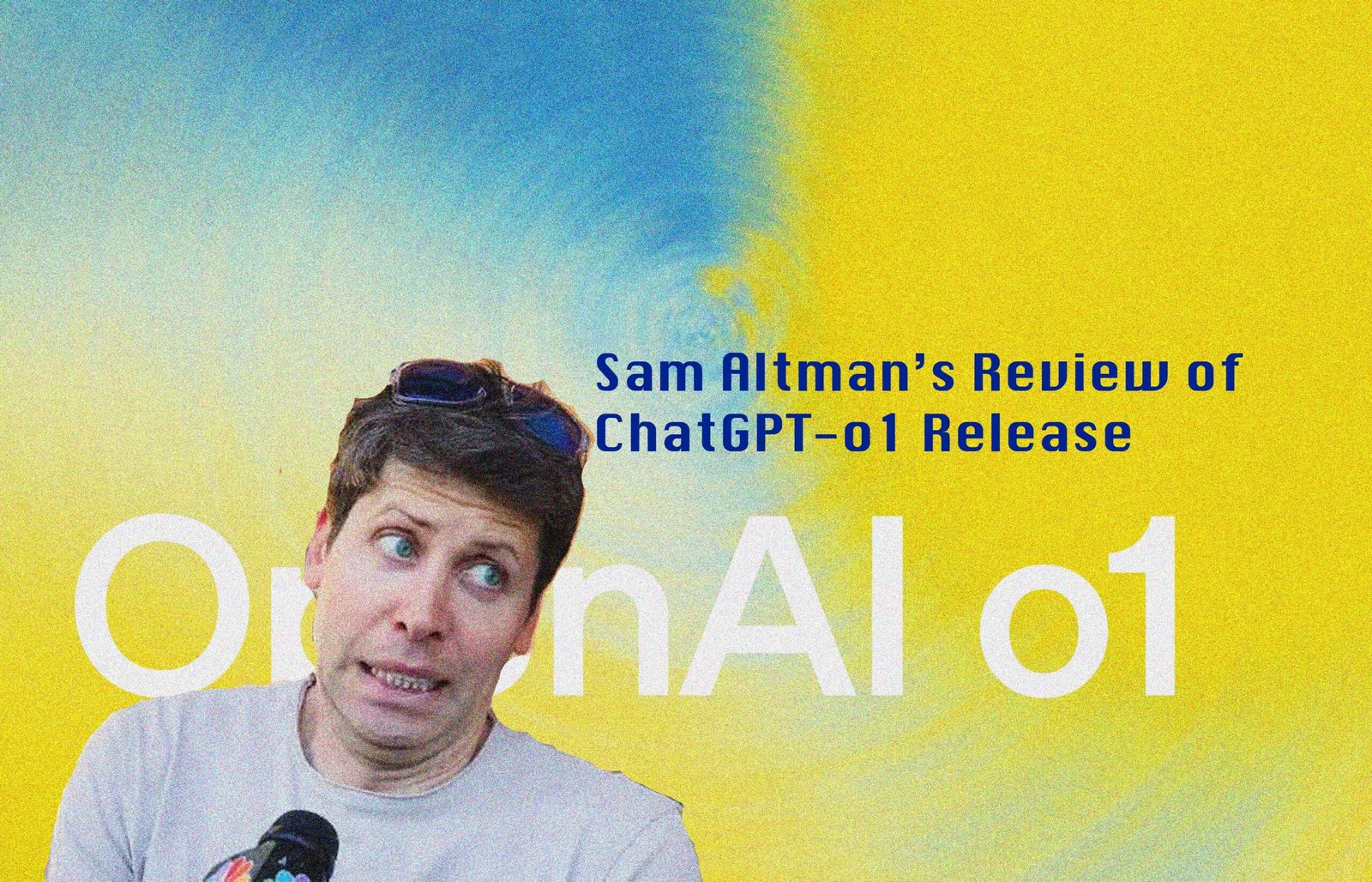In the ever-evolving landscape of artificial intelligence, OpenAI has once again pushed the boundaries with the release of its latest model, OpenAI o1. This groundbreaking AI, developed under the codename “Strawberry,” represents a significant leap forward in machine reasoning capabilities. Sam Altman, CEO of OpenAI, has shared his insights on this revolutionary release, highlighting its capabilities, new features, and what sets it apart from its predecessors. In this comprehensive review, we’ll explore the o1 model’s potential to reshape our interaction with AI and its implications for various industries.
We're releasing a preview of OpenAI o1—a new series of AI models designed to spend more time thinking before they respond.
— OpenAI (@OpenAI) September 12, 2024
These models can reason through complex tasks and solve harder problems than previous models in science, coding, and math. https://t.co/peKzzKX1bu
Overview of OpenAI o1
The OpenAI o1 model marks a departure from traditional AI approaches, prioritizing thoughtful problem-solving over rapid response generation. This new series of reasoning models is designed to mimic human-like reasoning processes by dedicating more time to analyzing problems before providing answers. The result is an AI system that excels in complex domains, particularly in science, mathematics, and coding.
Key Capabilities of OpenAI o1
Enhanced Reasoning Abilities
At the core of o1’s capabilities is its enhanced reasoning ability. Unlike previous models that relied heavily on pattern recognition and replication from training datasets, o1 employs advanced techniques to think through complex tasks. This approach allows it to tackle problems in STEM fields with a level of sophistication previously unseen in AI models.
Sam Altman emphasized that o1’s performance in these areas is particularly impressive. In rigorous testing, the model demonstrated capabilities on par with PhD students in physics, chemistry, and biology. This level of proficiency opens up new possibilities for AI assistance in advanced research and problem-solving across various scientific disciplines.
Exceptional Performance in Mathematics and Coding
One of the most striking features of o1 is its exceptional performance in mathematics and coding challenges. Altman highlighted some remarkable benchmarks:
- In a qualifying exam for the International Mathematics Olympiad (IMO), o1 achieved an astonishing 83% accuracy. This is a dramatic improvement over its predecessor, GPT-4o, which managed only 13% accuracy on the same test.
- The model ranked in the 89th percentile in competitive programming contests like Codeforces, showcasing its ability to handle complex algorithmic challenges.
These results indicate that o1 has the potential to be a powerful tool for mathematicians, computer scientists, and software developers, potentially accelerating research and development in these fields.
Chain of Thought Reasoning
One of the most intriguing aspects of o1, as noted by Altman, is its ability to display its thought process as it works through problems. This “chain of thought” reasoning not only provides transparency into the model’s decision-making process but also mimics human-like reasoning patterns. This feature could be particularly valuable in educational settings, allowing students to understand complex problem-solving strategies by observing the AI’s step-by-step approach.
Multimodal Capabilities
While not as fully developed as in some previous models, o1 does introduce some multimodal capabilities. This allows the model to process and generate outputs in multiple formats, including text and basic image understanding. However, Altman noted that these capabilities are still in development and not as advanced as those in models like GPT-4o.
Customizable Personalities
Another interesting feature of o1 is its ability to adopt customizable personalities. Users can define specific personality traits or tones for the model, making it adaptable to various contexts and use cases. This flexibility allows o1 to be tailored for different industries and communication styles, from formal business interactions to more casual, friendly exchanges.
New Features in OpenAI o1
Two Distinct Variants
OpenAI has introduced two versions of the o1 model, each tailored for specific use cases:
- o1-preview: This is the flagship version, aimed at complex reasoning tasks. It offers robust performance in coding and scientific problem-solving, making it ideal for researchers, developers, and academics working on challenging problems.
- o1-mini: A smaller and more cost-effective version optimized primarily for coding tasks. This variant is designed to be more accessible to a broader range of users while still offering significant improvements in coding-related tasks.
Advanced Training Methodology
Altman emphasized that o1 employs a novel training methodology that sets it apart from its predecessors. Unlike previous iterations that relied primarily on pattern replication, o1 utilizes reinforcement learning techniques. This approach allows the model to learn from rewards and penalties, enhancing its ability to solve problems independently and creatively.
API Enhancements for Developers
While specific details were limited, Altman mentioned that o1 comes with several API enhancements designed to make it easier for developers to integrate the model into their applications. These improvements include better documentation, more robust error handling, and improved tools for managing large-scale deployments.
Safety and Ethical Considerations
Consistent with OpenAI’s commitment to responsible AI development, o1 incorporates enhanced safety features and ethical considerations. Altman stressed that the model has been trained with stricter guidelines to prevent harmful outputs, such as misinformation, biased content, or inappropriate responses. This focus on safety and ethics is crucial as AI models become more powerful and influential.
What’s New in OpenAI o1
Focus on Reasoning Over Speed
One of the most significant changes in o1 is its prioritization of thorough reasoning over speed. While this can result in slower response times—sometimes taking over ten seconds for complex queries—it allows for more accurate and well-thought-out responses. Altman noted that this trade-off is intentional and aligns with OpenAI’s goal of creating AI that can tackle increasingly complex problems.
Improved Performance in Specialized Domains
O1 shows remarkable improvements in specialized domains, particularly in STEM fields. Its ability to perform at the level of PhD students in various scientific disciplines represents a significant leap forward in AI capabilities. This specialization could lead to breakthroughs in scientific research and problem-solving across multiple industries.
Novel Approach to Problem-Solving
The o1 model introduces a novel approach to problem-solving that more closely mimics human cognitive processes. By spending more time analyzing problems and displaying its chain of thought, o1 provides insights into its reasoning process, making it a valuable tool for education and complex decision-making scenarios.
Enhanced Collaboration Features
While not fully developed, Altman hinted at enhanced collaboration features in o1. The model supports shared sessions where multiple users can participate in the same conversation and collaborate on tasks in real-time. This feature has the potential to revolutionize team projects, brainstorming sessions, and group study.
Limitations and Challenges
Despite its impressive capabilities, Altman was candid about o1’s limitations:
Cost: The usage costs for o1 are significantly higher than those for previous models. For example, using the API for o1-preview costs $15 per million input tokens and $60 per million output tokens, compared to $5 and $2.50 respectively for GPT-4o. This could limit accessibility for some users and organizations.
- Speed: The model’s focus on thorough reasoning comes at the cost of speed. This slower processing time may not be suitable for all applications, particularly those requiring real-time responses.
- Feature Gaps: Currently, o1 lacks several features present in GPT-4o, including advanced web browsing capabilities, file uploads, and sophisticated image processing. These limitations may restrict its utility in certain applications.
- Ongoing Refinement: Altman emphasized that o1 is still in its early stages and will require ongoing updates and refinements to reach its full potential. He encouraged users to provide feedback to help improve the model over time.
User Access and Availability
OpenAI has implemented a phased rollout strategy for o1:
- Initially available to users with ChatGPT Plus and Team subscriptions.
- Users can manually select either the o1-preview or o1-mini models within ChatGPT.
- Weekly message limits are in place: 30 messages for o1-preview and 50 messages for o1-mini.
- Plans to extend access to educational institutions and enterprise users in the near future.
- Intentions to make o1-mini available to all free-tier users eventually.
Future Prospects
Altman expressed excitement about the future development of the o1 series. OpenAI has ambitious plans to gather user feedback actively and implement regular updates to improve performance and expand capabilities. Some potential future developments include:
- Enhanced browsing capabilities
- Support for file uploads
- Improved multimodal processing
- Further refinements to reasoning capabilities
- Expanded application in specialized industries
The introduction of OpenAI’s o1 model represents a significant milestone in the development of artificial intelligence. With its enhanced reasoning capabilities and focus on solving complex problems across various fields, it sets a new standard for AI performance.
Sam Altman’s review underscores both the excitement and the challenges associated with this groundbreaking release. While o1 demonstrates impressive capabilities in areas like mathematics, coding, and scientific reasoning, it also comes with limitations in terms of cost, speed, and certain features.
As OpenAI continues to refine the o1 model based on user feedback and technological advancements, we can expect even greater strides toward achieving human-like AI reasoning capabilities. The potential applications of o1 are vast, ranging from accelerating scientific research to revolutionizing education and problem-solving in various industries.
In summary, the release of OpenAI o1 marks a new chapter in AI development, one that prioritizes thoughtful reasoning and complex problem-solving. As the technology continues to evolve, it has the potential to transform how we interact with AI and leverage its capabilities to address some of the world’s most challenging problems.



